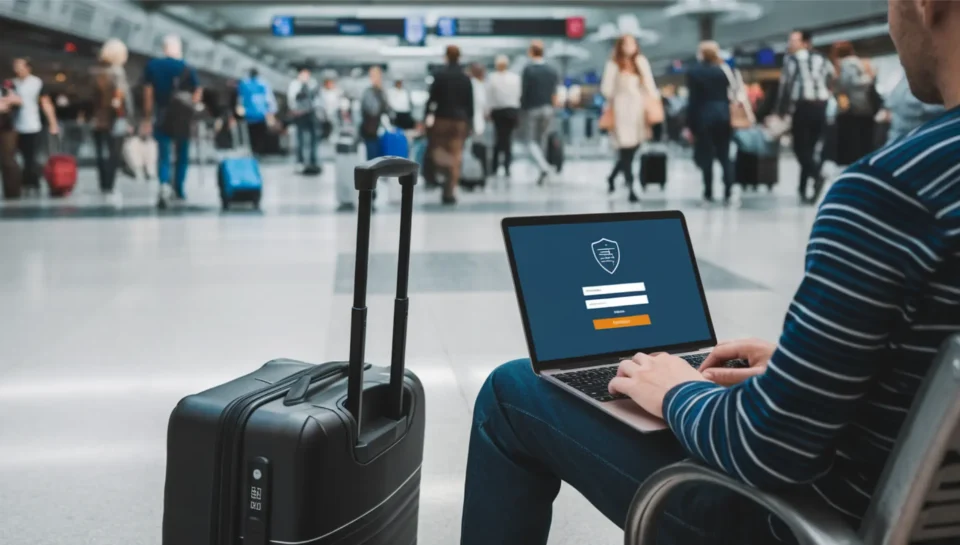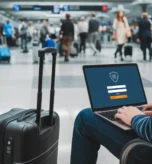Traveling for business often involves a delicate balance between accessibility and security. On the one hand, business travelers need constant connectivity to respond to emails, participate in video conferences, and access critical company systems. On the other hand, this constant connectivity exposes them to unique cybersecurity risks, especially when operating in unfamiliar or less secure environments such as hotels, airports, or public transportation hubs. The growing sophistication of cybercriminals further complicates matters, as they increasingly exploit the vulnerabilities that arise from travelers’ reliance on public Wi-Fi networks, mobile devices, and portable storage solutions. As a result, understanding and addressing these risks has never been more critical for maintaining both personal and professional data integrity during business trips.
Traveling for business often involves a delicate balance between accessibility and security. On the one hand, business travelers need constant connectivity to respond to emails, participate in video conferences, and access critical company systems. On the other hand, this constant connectivity exposes them to unique cybersecurity risks, especially when operating in unfamiliar or less secure environments such as hotels, airports, or public transportation hubs. The growing sophistication of cybercriminals further complicates matters, as they increasingly exploit the vulnerabilities that arise from travelers’ reliance on public Wi-Fi networks, mobile devices, and portable storage solutions. As a result, understanding and addressing these risks has never been more critical for maintaining both personal and professional data integrity during business trips.
The Risks of Traveling Without Cybersecurity Measures
Business travelers frequently face unique cybersecurity threats, which can compromise both personal and professional data. Without proper precautions, travelers may unintentionally expose themselves to malicious actors seeking to exploit their reliance on digital tools and networks. These risks are amplified in unfamiliar environments where travelers may not have the same level of control over their devices and connections. Common cybersecurity threats include:
- Unsecured Networks: Airports, hotels, and coffee shops often provide free Wi-Fi, which is highly susceptible to hacking.
- Physical Theft: Devices left unattended can be easily stolen, exposing valuable data.
- Phishing Attacks: Travelers are prime targets for phishing scams due to their reliance on email and messaging apps.
- Juice Jacking: Public charging stations can be used to install malware on devices or steal data.
Real-World Examples of Cyber Threats
Imagine connecting to an airport’s free Wi-Fi, only to have a hacker intercept sensitive emails or steal login credentials. Public Wi-Fi networks often lack encryption, allowing cybercriminals to launch “man-in-the-middle” attacks, where they intercept and potentially alter your communications. Another scenario involves losing a company laptop, giving a thief access to proprietary information such as business plans, financial documents, or sensitive client data. Even a laptop secured with a basic password might not withstand advanced hacking attempts, leaving your company exposed to significant risks. Or consider plugging into a public charging station and unknowingly compromising your device through “juice jacking,” where malicious software is installed via the charging port. This software could silently copy files, track keystrokes, or grant the attacker remote access to your device. Such scenarios highlight the importance of taking preventive measures to mitigate the growing threats that travelers face in today’s interconnected world.
10 Steps to Safeguard Your Business While Traveling
1. Secure All Devices
Ensuring the security of your devices is the first line of defense against cyber threats. Start by installing reputable antivirus software to protect against malware and ransomware. Disable Bluetooth when it is not in use, as open Bluetooth connections can serve as an entry point for hackers. Biometric authentication, such as fingerprint or facial recognition, adds an additional security layer. Finally, encrypt your device storage to ensure that even if your device is stolen, your sensitive data remains secure.
- Install Antivirus Software: Protect against malware and ransomware.
- Disable Bluetooth When Not in Use: Prevent unauthorized access to your device via Bluetooth connections.
- Use Biometric Authentication: Features like fingerprint or facial recognition add an extra layer of security.
- Encrypt Device Storage: Full-disk encryption protects your data even if your device is stolen.
2. Use a Virtual Private Network (VPN)
A Virtual Private Network (VPN) creates a secure and encrypted tunnel for your internet traffic, shielding it from prying eyes. Choose a VPN provider with robust encryption protocols and a strict no-logs policy to ensure your data remains private. Enable the auto-connect feature to ensure the VPN activates automatically whenever you connect to a new or unsecured network. For advanced security, consider using VPNs with multi-hop servers, which route your traffic through multiple servers to add additional layers of protection.
- Choose a Trusted Provider: Use a VPN with strong encryption and a no-logs policy.
- Enable Auto-Connect: Set up the VPN to activate automatically on unsecured networks.
- Multi-Hop Servers: Consider VPNs that route traffic through multiple servers for added protection.
3. Regularly Update Devices and Apps
Cybercriminals frequently exploit vulnerabilities in outdated software. To counter this, enable automatic updates for your apps and operating systems to ensure they remain up to date. Before traveling, audit your devices to verify that all software is current and functioning properly. Removing unnecessary or unused apps not only reduces potential vulnerabilities but also frees up valuable storage space.
- Enable Automatic Updates: Keep all apps and operating systems current.
- Update Before Traveling: Ensure everything is up to date before departure.
- Audit Installed Apps: Remove any unused or unnecessary apps to reduce vulnerabilities.
4. Avoid Public Wi-Fi When Possible
Public Wi-Fi networks are often unsecured and serve as a playground for hackers. Whenever possible, use your personal smartphone as a hotspot to create a more secure connection. If you must use public Wi-Fi, verify the network’s legitimacy by confirming its name with the staff. For additional security, consider using a portable Wi-Fi router that allows you to create your private network with customizable settings.
- Use a Personal Hotspot: Your smartphone’s hotspot is a safer alternative.
- Verify Wi-Fi Networks: Ensure the network is legitimate by checking with staff.
- Use a Portable Wi-Fi Router: Create your private network with secure settings.
5. Backup All Critical Data
Data loss can be catastrophic, especially during business travel. To prepare for such scenarios, automate your backups using secure cloud services like Google Drive or Dropbox. Additionally, carry an encrypted USB drive to store essential files as a fail-safe measure. Periodically test your backup solutions to ensure you can successfully retrieve and restore your files when needed.
- Use Cloud Services: Automate backups to secure platforms like Google Drive or Dropbox.
- Carry an Encrypted USB Drive: Store essential files on secure external devices.
- Test Backup Functionality: Confirm you can retrieve your files from backups if needed.
6. Use Secure Communication Tools
Secure communication is vital for protecting sensitive business discussions. Use encrypted messaging apps like Signal or WhatsApp to safeguard your conversations. For voice calls, rely on secure VoIP platforms that provide end-to-end encryption. Always be cautious about discussing sensitive topics in public spaces where your conversations could be overheard.
- Encrypted Messaging Apps: Use tools like Signal or WhatsApp.
- Secure VoIP Platforms: Rely on services with end-to-end encryption for voice calls.
- Avoid Discussing Sensitive Topics in Public: Be mindful of your surroundings.
7. Protect Financial and Sensitive Accounts
Financial accounts and sensitive data are prime targets for cybercriminals. Enhance account security by enabling multi-factor authentication (MFA), which adds an additional verification step beyond just passwords. Set up real-time alerts for suspicious account activity to catch unauthorized access immediately. To minimize risks, uninstall non-essential financial apps while traveling and use secure web portals instead.
- Enable Multi-Factor Authentication (MFA): Add an extra layer of security to your accounts.
- Set Account Alerts: Monitor for unusual activity with instant notifications.
- Remove Financial Apps Temporarily: Uninstall non-essential apps while traveling.
8. Safeguard Physical Documents and Devices
Physical security is as important as digital security when traveling. Always lock your devices with strong passwords and enable encryption to protect stored data. Use RFID-blocking wallets to prevent unauthorized scanning of your payment cards. To secure your devices and documents further, invest in tamper-proof bags or cases that make it difficult for thieves to access your belongings.
- Lock Devices: Use strong passwords and device encryption.
- Carry RFID Wallets: Prevent unauthorized scanning of credit cards.
- Use Tamper-Proof Bags: Protect devices and documents from theft.
9. Monitor for Suspicious Activity
Vigilance is crucial in identifying and mitigating threats. Regularly review your bank account and email activity for any unauthorized actions or anomalies. Utilize dark web monitoring services that alert you if your sensitive information has been exposed online. If you detect suspicious activity, report it immediately to your IT team or financial institution to minimize potential damage.
- Review Account Activity Regularly: Check bank accounts and emails for unauthorized actions.
- Use Dark Web Monitoring Services: Get alerts if your information appears on the dark web.
- Report Issues Immediately: Inform your IT team or bank about any suspicious activity.
10. Educate Yourself and Your Team
Knowledge is one of the most powerful tools in cybersecurity. Before traveling, participate in training sessions to learn how to identify phishing attacks, fake networks, and other common threats. Establish clear emergency protocols for reporting and addressing incidents effectively. Conduct regular mock drills to simulate real-life cybersecurity scenarios, improving your response times and preparedness for potential attacks.
- Pre-Travel Training: Learn to identify phishing attacks and fake networks.
- Establish Emergency Protocols: Have clear steps for reporting and addressing incidents.
- Conduct Mock Drills: Simulate cybersecurity scenarios to improve response time.
Conclusion
Business travel doesn’t have to mean sacrificing cybersecurity, but it does require vigilance and proactive planning. Cyber threats are a reality for anyone navigating today’s digital landscape, and the risks multiply when traveling, as devices and data become more exposed. By implementing these ten comprehensive steps, such as securing devices, using VPNs, and avoiding public Wi-Fi, you create a robust defense against potential breaches. Additionally, fostering a mindset of continuous awareness, from monitoring suspicious activity to educating yourself on emerging threats, ensures you remain one step ahead of cybercriminals. Your preparation not only safeguards your data but also gives you peace of mind, allowing you to focus on your professional goals without unnecessary worry. Ultimately, diligence and a commitment to best practices can turn cybersecurity from a daunting challenge into a manageable and effective shield for your personal and business endeavors.



